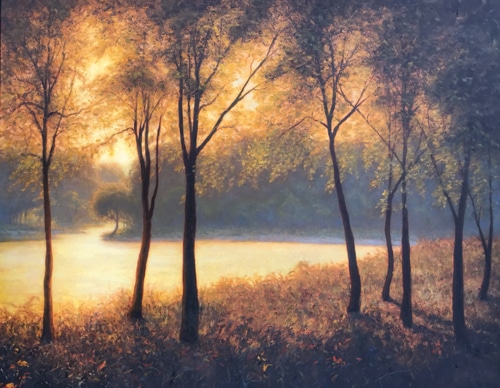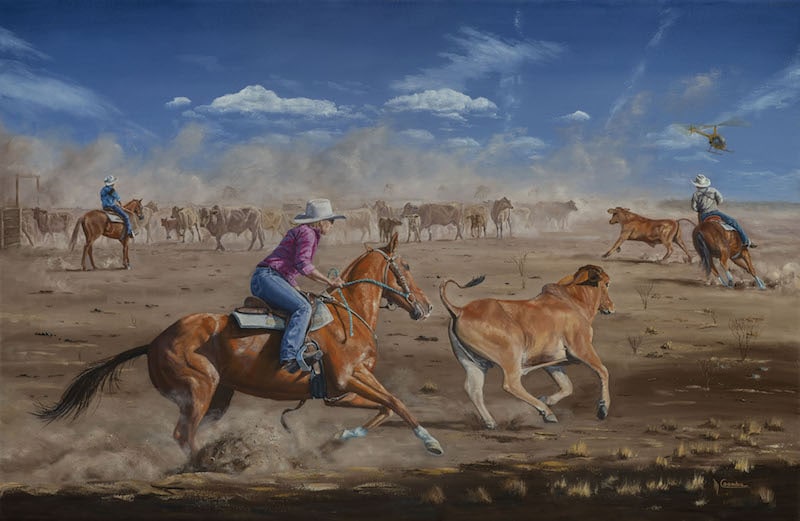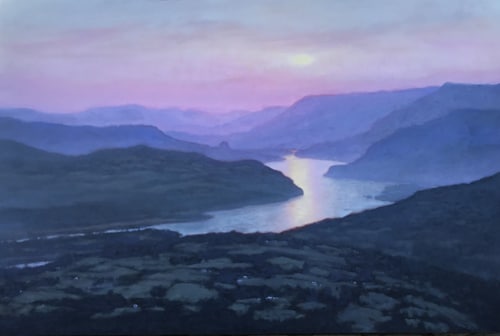Dave Geada is the CMO of FASO/BoldBrush. In this Q&A with CHF Sales and Events Director Carolyn Edlund, Dave discusses the permanent effects Coronavirus has had on the art market, and what artists must know in order to thrive in this brave new world.
Carolyn Edlund: The Covid 19 virus has created an unprecedented disruption of the art market. What is your best guess as to behavioral changes and outcomes we will see during and after the pandemic?
Dave Geada: Well, I think we’re all witnessing and experiencing a fundamental paradigm shift that will have enormous ripple effects in terms of how we interact socially and conduct business. I’m talking on the same scale as the shift that occurred when the internet came along, or when Apple launched the iPhone, or Facebook gained dominance.
The paradigm shift that I’m referring to is our acceptance and widespread adoption of technology designed to help us interact at a distance. This shift has been occurring very slowly over many years, and mainly in tech circles, but recent events have dramatically accelerated it.
The people who work in technology startups and for big technology brands like Google, Facebook, and Amazon have been using these platforms for years. They include video conferencing software platforms like Zoom and Google Hangouts, instant messaging platforms like Slack and Facebook messenger, and streaming platforms like Youtube, Twitch and Facebook Live. They also include emerging technologies like virtual reality (VR) and artificial intelligence (AI) in the form of chatbots that enable companies to interact effectively with their customers at enormous scale.
Up until now these technologies have served particular niches or been passed over as curiosities by most of us. The pandemic has changed all that, possibly forever.
If you’re scratching your head at all of this techno mumbo-jumbo, you’re not alone. Up until the arrival of the coronavirus pandemic, these technologies haven’t really caught on with the rest of us. But that’s radically changed in the last few weeks.
I’ll give you an example of what I’m talking about from my own experience. My mother-in-law, whom I love with all my heart, is like many of us when it comes to how she uses technology. Up until a few weeks ago, she used her smartphone mostly for voice calling family and friends, playing Words with Friends, and the occasional Facebook post. In the last few weeks she’s learned how to use Facetime instead of voice calling and her use of Facebook has grown exponentially. It’s now one of the main ways that she stays in touch with everyone she knows.
Artists are feeling these effects as well. I’ve literally had dozens of conversations with artists recently who have reached out to me for advice on how to run workshops and classes on Zoom, Crowdcast.io, and other video conferencing platforms. I’ve also spoken with even more artists asking me how to run exhibits online.
Now mind you, all the artists I’ve spoken with are just like most of us. They struggle with technology. But they have no choice but to adapt to this strange new world, so they’re jumping in with both feet.

Here’s the punchline and something to consider if you find yourself hesitating to jump in yourself. The longer this pandemic sticks around, the faster and more widespread these behavioral changes I’ve been talking about will spread. Even those of us who are technophobes and still violently cling to older ways of doing things will have no choice but to use these technologies in order to stay connected and employed. And at a certain point they will become permanent fixtures in our lives, just like the lightbulb and television.
CE: Do you think this will change art marketing and sales permanently as the market shifts to accommodate new ways of thinking?
DG: Absolutely! And just like in the broader economy, the longer this pandemic goes on the more permanent these shifts will become when it comes to marketing and selling art.
But make no mistake, the reason that this is happening in the art world and everywhere else so quickly and in such a widespread fashion is because the pandemic is accelerating a shift that was already occurring!
Here’s an example of what I’m talking about. For decades, the wealthiest collectors of art have been able to bid in art auctions without ever attending the auction in person. As a matter of fact, most of the artwork that auction houses like Christie’s and Sotheby’s have sold at auction in the last thirty years have been bought by people who were bidding from half a world away! And this predates even the internet!
When you fast forward to this past decade, more and more art has been sold sight unseen over the internet than anyone ever suspected. Many of you might be surprised to learn, for example, that our members sold $1.5M worth of art on FASO last year!
But the impacts being felt in the art world go beyond how collectors are buying art. It’s being felt right now in how artists reach and engage collectors. As galleries are forced to close their exhibits and some galleries themself are forced to shut down as a result, more and more artists are coming to the realization that they need to own their own marketing and adapt before it’s too late.
This isn’t easy, and frankly that’s because there’s a lot of expert advice out there that works great for online retailers or social media influencers, but doesn’t work out to be great for artists. You see, online retailers only have to market their products. So they can invest most of their time on things like SEO, posting on every social media platform five times a day, and optimizing paid search campaigns.
Artists, on the other hand, don’t have that luxury of time because they have to both make and market their artwork. So the artists that are making this transition are going about it in a very smart way.
These artists are focusing on the 20% of marketing activities that generate 80% of their art sales. And they’re adopting these technologies that I talked about earlier to connect with their audience virtually.
They’re holding exhibits online on platforms like Facebook Live, teaching classes and workshops on Zoom and Crowdcast.io, and the most ambitious ones are delivering online instructional art courses on platforms like Podia. And guess what? They’re making a ton of money doing it because this is exactly what the market needs and wants right now!
The longer that this pandemic goes on, the more art buyers will come to expect artists to engage with them in this way. If you think about it, we’re witnessing a revolution in how art gets marketed and sold that will forever put artists in the driver’s seat when it comes to selling their art. That is if artists are willing to adapt to the times and jump in with both feet.
CE: Many artists are looking to make online art sales to replace canceled in-person events and want to ramp up quickly. What do you feel is the most effective way to get started?
DG: The easiest way to get started is to hold an online exhibit of your artwork with Facebook Live and to promote the event on social media and through your newsletter if you have one (which you should, by the way!)
The great thing about Facebook Live is that you don’t need to get fancy and buy a lot of equipment to get started. You can hold a Facebook Live event with your smartphone. As a matter of fact, you can make a lot of money doing it this way!

I’ll share an example of what I’m talking about. We have a member on FASO by the name of Mark Coombe. He’s an outback artist that lives in Australia. Essentially outback art is the equivalent of our own cowboy art here in the states.
Now just like many of us, Mark and his neighbors were recently put under strict lockdown orders. That meant that a show he was planning to open in a couple of weeks couldn’t happen. His daughter suggested that he try holding a Facebook Live event instead. So they promoted the event to Mark’s Facebook followers, hung a bunch of his artwork up in his barn, and launched it. You can find Mark’s Facebook Live exhibit on his Facebook page.
Mark’s daughter is the one filming the exhibit, and one of my favorite things about it is the back-and-forth conversation between Mark and his daughter, especially in the beginning where she’s counting off how many followers have joined the event.
The event itself only lasts about 15 minutes, and it’s just Mark talking about his artwork and how folks can purchase it on his FASO website. There’s nothing fancy going on here, which is why you may be shocked when I tell you that Mark sold 19 works in under two days through this event! In fact, he told me afterwards that he sold more art online this way than he ever expected to sell at his in-person exhibit. That’s because people from all over the world who would have never turned up for his in-person exhibit were buying his art online!
Mark’s story illustrates a few important characteristics that artists need to adopt if they want to thrive in this new world. Artists need to:

- Adapt and execute quickly if they want to reap the rewards. Perfection is the enemy of good enough here. There was nothing perfect about Mark’s video. In fact, most of the charm was in how down-to-earth and imperfect it was. In an age where news commentators are broadcasting from their closets, production value doesn’t matter. What matters is speed.
- Own their own marketing. Notice how Mark didn’t wait around for a gallery to save the day. He jumped right in and took ownership for making this event happen. Artists that follow suit will be the ones to thrive and outlast others long after this pandemic is over.
- Don’t be afraid to ask for help. Notice how Mark’s daughter helped him with the technology bits he wasn’t comfortable doing himself. They made a great team and sold a lot of art together. So don’t be afraid to ask friends and family to help you if they can.
Speaking of asking for help, that extends to organizations like BoldBrush and The Clark Hulings Foundation as well.
Now’s a great time, for example, to take an online course at CHF to bone up on these important business skills. BoldBrush also provides a ton of resources to help. One of my favorites is our FineArtViews newsletter, which is free and chock full of great tips on marketing and selling art in these crazy times.
CE: Given your research into the ways collectors respond to marketing messages, what approach do you suggest artists take to get the best possible result?
DG: As you know, we’ve spent a lot of time and effort looking into this. And what we’ve discovered is that the artists who take a storytelling approach to their marketing messages are the most successful in engaging collectors and getting them to buy their art.
Many of your readers may be wondering what I mean by this and how this all works. So let me share a story with you about an artist I know who asked me the same question. I think it will help illustrate what I’m talking about.
We have this wonderful artist on FASO by the name of Michael Orwick. Michael recently joined us for a storytelling webinar that we worked on together a short time ago. (Daniel DiGriz was amazing, by the way!).
Michael joined us for the live event and then put together a newsletter article where he tried to apply the storytelling principles that we discussed. He sent me an email asking me to critique his article, which I did.
Michael’s article began this way:
“I don’t know why, but I’ve always had a strong connection with the natural world…”
He went on to describe how this connection influenced him personally and professionally.

When it comes to storytelling, we teach artists about the importance of being genuine and vulnerable. That the more you open up and share your story, warts and all, the more likely your audience will connect with you as an artist and eventually buy your art. And I felt that Michael just hadn’t lived up to that standard with his story.
You see, the thing I thought was the most interesting and most relevant part of his story was the part he had glossed over, namely the why.
Why did nature affect him this way? If he could answer that for himself and his audience, then he would truly be living up to that ideal of great storytelling that I described. He would be revealing something about himself at a deep and visceral level that would grab the attention of his audience and open a window on what makes him tick as an artist.
Michael is an amazing guy. He took my feedback to heart and went back to the drawing board with his story. And when he thought he had nailed it, he reached out to the good folks at Plein Air Magazine and sent them a copy of it.
So guess what happened? They loved it! They plan on publishing it in an upcoming edition of the magazine. That’s the power of great storytelling. But it only happens when you’re willing to dig deep and share your innermost self with your audience.
CE: We know that artists thrive best in a supportive environment, which makes the art community vital in this unpredictable climate. How would you suggest artists use the power of their network to keep their businesses on track?
DG: I’ve always told artists that one of the most important keys to success is your network. The people you surround yourself with, who support you, encourage you, and push you, are your greatest resource. In my experience, the artists who actively grow and nurture their networks with intention and purpose are the ones that are always the most successful.
Your question, though, presumes that most artists already have a network like this in place. I find that the opposite is more often true. Most artist’s lack a robust network to help them and aren’t sure how to get one started.
So here’s my advice, which boils down to two words. Be Helpful.
The key to building a great network is to give before you get. So join a local, regional, or national art association and figure out what you can do to get involved and help them in their mission. If you’re already a member of one, reach out to the organizers and offer to help in some way. If there isn’t a group in your area, start one. But don’t stop there.
Make it a point of reaching out to the artists in your area and get to know them. Then offer to help them in some way. Whether that’s by helping to promote their next show, making an introduction, or just offering some advice.
Reach out to The Foundationraiser at a local charity and offer to donate your art for a charity auction to help raise money. But don’t stop there. Offer to help put the auction together and participate in the event to help raise the bids on your art.
I could list some other examples, but I think I’ve made my point. Figure out how to help someone else first. If you do, here are two crazy things you’ll experience:
- You’ll start feeling better about your own situation. It’s weird, but true. When we focus on helping others with their problems and challenges, it often makes us feel better about our own situation. Our problems don’t go away, but helping others makes us feel more hopeful. Because if we can help others, we’re more confident about helping ourselves.
- Opportunities will find you. It might be a cliche, but what goes around does come around. When you help others, those people that you help feel an obligation to help you back even when you don’t ask for their help. They can’t help themselves. They’re more likely to mention you to others positively, more likely to connect you with others that can help you, and so forth. It opens doors for you and makes those people that you’ve helped feel better about their own situation.
One objection I often hear when I propose this to artists is what I call the Who Me Trap. It goes something like this:
“Who me? You want me to be helpful and offer advice? I’m not qualified enough, experienced enough, smart enough, etc.”
Those two words and all they imply are one of the biggest obstacles to growing your network in this way. And what kills me about it is that it’s just a lie we tell ourselves to feel better about not taking a risk.
The truth is that we’re all experts to someone else. Because the only difference between you and an expert is that an expert is just someone one or two steps ahead of you. But those two steps mean all the difference to someone behind you on the learning curve.
So don’t fall for the Who Me Trap when it comes to building out your network. Don’t make excuses and don’t be afraid to put yourself out there and get involved. I guarantee you that your actions will make a difference in someone’s life, and that can only lead to good things for you and your art career.



